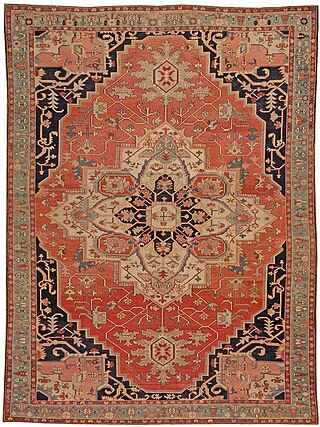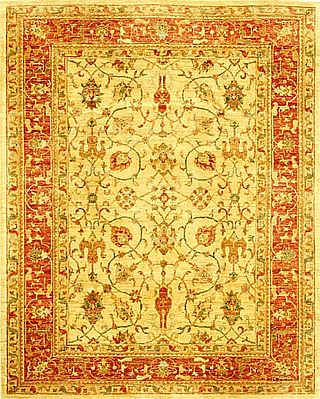
A carpet is a textile floor covering typically consisting of an upper layer of pile attached to a backing. The pile was traditionally made from wool, but since the 20th century synthetic fibers such as polypropylene, nylon, or polyester have often been used, as these fibers are less expensive than wool. The pile usually consists of twisted tufts that are typically heat-treated to maintain their structure. The term carpet is often used in a similar context to the term rug, but rugs are typically considered to be smaller than a room and not attached to the floor.

A Persian carpet, Persian rug, or Iranian carpet is a heavy textile made for a wide variety of utilitarian and symbolic purposes and produced in Iran, for home use, local sale, and export. Carpet weaving is an essential part of Persian culture and Iranian art. Within the group of Oriental rugs produced by the countries of the "rug belt", the Persian carpet stands out by the variety and elaborateness of its manifold designs.

A kilim is a flat tapestry-woven carpet or rug traditionally produced in countries of the former Persian Empire, including Iran, but also in the Balkans and the Turkic countries. Kilims can be purely decorative or can function as prayer rugs. Modern kilims are popular floor coverings in Western households.

The Iranian city of Isfahan has long been one of the centres for production of the famous Persian carpet. Isfahani carpets are renowned for their high quality. The most famous workshop in Isfahan is Seirafian. In Europe, they became incorrectly known as Polish rugs because of the trade route from Persia to France running through Poland.

The Ardabil Carpet is the name of two different famous Persian carpets, the larger and better-known now in the Victoria and Albert Museum in London. Originally there were two presumably identical carpets, and the London carpet, as restored and reconstructed in the 19th century, uses sections from both. It now measures 34 ft 3 in × 17 ft 6+7⁄8 in. The other carpet, now in the Los Angeles County Museum of Art, and smaller at 23 ft 7 in × 13 ft 1+1⁄2 in, was made up of the sections in adequate condition unused for the London carpet. Both carpets are now smaller than they would have been originally, and there are other fragments in various collections that appear to come from the reconstruction process. The carpets have a typical Tabriz design, with one central medallion and smaller, ornate designs surrounding. Such medallions and shapes were central to the design and reality of Persian gardens, a common symbol of paradise for followers of Islam.

Bijar is a city in the Central District of Bijar County, Kurdistan province, Iran, serving as capital of both the county and the district.

The George Washington University Museum and Textile Museum is a museum in Washington, D.C., dedicated to the history of George Washington University and textile arts, located in the Foggy Bottom neighborhood. The museum was founded by collector George Hewitt Myers in 1925 and was originally housed in two historic buildings in D.C.'s Kalorama neighborhood: the Myers family home, designed by John Russell Pope, and an adjacent building designed by Waddy Wood. It reopened in March 2015 as part of George Washington University.
An oriental rug is a heavy textile made for a wide variety of utilitarian and symbolic purposes and produced in "Oriental countries" for home use, local sale, and export.

Heriz rugs are Persian rugs from the area of Heris in northwest Iran, northeast of Tabriz. Such rugs are produced in the village of the same name in the slopes of Mount Sabalan. Heriz carpets are durable and hard-wearing and they can last for generations. 19th century examples of such carpets are often found on sale by major auction houses in United States and Europe. Part of the reason for the toughness of Heriz carpets is that Mount Sabalan sits on a major deposit of copper. Traces of copper in the drinking water of sheep produces high quality wool that is far more resilient than wool from other areas. The Heris Carpet is the only carpet in the world where stories of the Old times are woven.

Anatolian rug or Turkish carpet is a term of convenience, commonly used today to denote rugs and carpets woven in Anatolia and its adjacent regions. Geographically, its area of production can be compared to the territories which were historically dominated by the Ottoman Empire. It denotes a knotted, pile-woven floor or wall covering which is produced for home use, local sale, and export, and religious purpose. Together with the flat-woven kilim, Anatolian rugs represent an essential part of the regional culture, which is officially understood as the Culture of Turkey today, and derives from the ethnic, religious and cultural pluralism of one of the most ancient centres of human civilisation.
Iranian handicrafts are handicraft or handmade crafted works originating from Iran.

Carpets of Middle-Eastern origin, either from Anatolia, Persia, Armenia, Levant, the Mamluk state of Egypt or Northern Africa, were used as decorative features in Western European paintings from the 14th century onwards. More depictions of Oriental carpets in Renaissance painting survive than actual carpets contemporary with these paintings. Few Middle-Eastern carpets produced before the 17th century remain, though the number of these known has increased in recent decades. Therefore, comparative art-historical research has from its onset in the late 19th century relied on carpets represented in datable European paintings.

Bakshaish rugs and carpets are a tapestry from the village of Bakshaish in north-west Iran. Bakshaish is situated in the mountainous region 60 miles east of the large city of Tabriz. Its rugs are notable for their diverse abstract adaptations of old tribal and classical Persian motifs.

Caucasian carpets and rugs are primarily made in villages, rather than in cities. They are made from materials particular to individual tribal provinces, the rugs of the Caucasus normally display bold geometric designs in primary colors. Styles typical to the Caucasus region are Daghestan, Verne, Shirvan, Ganja, Kazakh, Karabagh, and Quba rugs. Several carpet styles from contemporary northwestern Iran also fall largely into this bracket, such as the Ardabil rugs.
Essie is a given name and nickname/hypocorism usually used as a feminine name.

Kerman carpets are one of the traditional classifications of Persian carpets. Kerman is both a city and a province located in south central Iran. The term also sometimes describes a type which may have been made elsewhere. Typical manufacturing techniques use an asymmetrical knot on cotton foundation, but less frequent examples incorporate silk or part silk piles, or silk foundations with wool pile.
Varamin carpets and rugs or Veramin carpets and rugs are carpets and rugs woven in city of Varamin and its surrounding area, southeast of Tehran. Many rug and carpet experts see Varamins as being among those Persian carpets most authentic in terms of traditional style and motif.

Ziegler & Co. was a Manchester-based Anglo-Swiss producer and distributor of Persian carpets in the late nineteenth and early twentieth centuries. The company had workshops in Tabriz and Sultanabad, and it supplied retailers such as Liberty & Company and Harvey Nichols.
Afshar is a handwoven rug style produced by the Turkic Afshar tribe, a semi-nomadic group principally located in the mountainous areas surrounding the modern region of Iranian Azerbaijan. An additional population of Afshar tribes-people is located in the Kuchan area in Razavi Khorasan Province of Iran and city of Kerman. Carpets in the Afshar style are known for their stylized floral geometric designs, tribal artistry, and a characteristic palette of rust and blue color tones.

The Oriental Carpet Manufacturers (OCM) was a London-based company involved in the production of, and trade with, Oriental carpets. Established in 1907/8 in Istanbul, the company set up and controlled their own carpet manufactures in the central Anatolian region around the town of Konya, and from 1911 onwards, in the Hamadan Province in northwestern Iran. In 1983 it was sold, and merged with one of its former affiliates, the Eastern Kayam Company. From 1924 until 1948, OCM was led by Arthur Cecil Edwards, who, after retiring, wrote a text book on Persian Carpets, which is still in print today.















